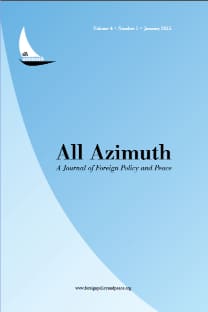Norway and Turkey: Possibilities of Cooperation through the Eyes of Turkish Opinion-Makers
Norway and Turkey: Possibilities of Cooperation through the Eyes of Turkish Opinion-Makers
The authors conducted interviews with opinion-makers in Turkey in 2012 to explore the feasibility of cooperation between Turkey and Norway on issues of peacebuilding. Norway was viewed by respondents as a country with softpower capabilities and a focus on human rights, democratic values, and the rule of law. Some opinion-makers also emphasized that both countries havea similar position on Palestine, a pivotal issue in the Middle East. Obstacles to cooperation include the geographical distance between the two countries, the lack of common institutions, Norway’s lack of experience with different ethnicities and faiths, Norway’s failure to object to the 2005-2006 Danish cartoon scandal regarding Mohammed, Norwegian criticism of Turkey’spolicies toward the Kurds, and its imprisonment of dissidents without due process of law. Despite these issues, respondents expressed enthusiasm about future cooperation, and view Norway as a far better potential collaborator than any other European country, in part because it, like Turkey, is outside the EU but a member of NATO. The issue of trade-offs between Norway’s use of soft power and its economic aspirations, namely oil investments in other countries, was also explored. The article concludes with a discussion of the possibility that increased cooperation between Turkey and Norway may give rise to “Turkophobia”, an extension of “Islamophobia”, a simplistic interpretative framework that rests on cultural misunderstanding and miscommunication.
Keywords:
Turkish-Norwegian cooperation, peacebuilding, democracy soft power, tradeoffs, Turkophobia,
___
- Aberbach, Joel D., and Bert A. Rockman. “Conducting and Coding Elite Interviews.” Political Science and Politics 35 (2002): 673-676.
- Andersen, Kent, and Christian Tybring Gjedde. “Drİm fra Disneyland.” Aftenposten, August 27, 2010. Accessed December 18, 2012. http://www.aftenposten.no/meninger/kronikker/article3783373.ece.
- Bangstad, Sindre. “Norway: Terror and Islamophobia in the Mirror.” Open Democracy, August 27, 2011. Accessed December 18, 2012. http://www.opendemocracy.net/sindre-bangstad/norway-terror-and-islamophobia-in- mirror.
- Berry, Jeffery M. “Validity and Reliability Issues in Elite Interviewing.” Political Science and Politics 35 (2002): 679-682.
- Bruner, Jerome S. “On Perceptual Readiness.” Psychological Review 64 (1957): 123-151.
- “ECRI Report on Norway (Fourth Monitoring Cycle),” Council of Europe: European Commission against Racism and Intolerance (ECRI), February 4, 2009: 27. Accessed December 18, 2012, http://www.unhcr.org/refworld/ docid/49e8891af.html.
- Ferraris, Maurizio. History of Hermeneutics. New York: Humanities Press, 1996.
- Fuller, Graham E. “Turkey’s Strategic Model: Myths and Realities.” The Washington Quarterly 27 (2004): 51-64.
- Gadamer, Hans Georg. “Interview: Writing and the Living Voice.” In Hans-Georg Gadamer on Education, Poetry and History, edited by Dieter Misgeld and Graeme Nicholson, 63-71. New York: State University of New York Press, 1992.
- releases/2012/increased-cooperation-between-norway-and.html?id=668571.
- Saz, Gökhan. “Turkophobia and Rising Islamophobia in Europe: A Quantification for the Negative Spillovers on the EU Membership Quest of Turkey.” Journal of Social Science 19 (2011): 479-491.
- Sherif, Musafer, and Carolyn W. Sherif. Social Psychology. New York: Harper & Row, 1969.
- Skånland, Øystein Haga. “Norway is a Peace Nation: a Discourse Analytic Reading of the Norwegian Peace Engagement.” Cooperation and Conflict 45 (2010): 35-54.
- Stærk, Bjİrn. “En Nettreise gjennom Islam-kritikkens Tiår.” Samtiden 4 (2011): 32-49.
- Stİre, Jonas G. ”Utenrikspolitikk i Forandringens tid.” Samtiden 4 (2010): 4-19.
- Tajfel, Henri. “The Anchoring Effects of Value in a Scale of Judgments.” British Journal of Psychology 50 (1959): 294-304.
- Tansey, Oisin. “Process Tracing and Elite Interviewing: a Case for Non-probability Sampling.” Political Science and Politics 40 (2007): 765-772.
- “Turkey from Ataturk to Erdogan.” Asharq al-Awsat, November 9, 2007. Accessed February 9, 2013, http://www. aawsat.net/2007/11/article55260861.
- “Turkish Model has Shortcomings.” Oxford Analytica, February 21, 2011. Accessed February 05, 2013. http:// www.relooney.info/0_NS4053_1608.pdf.
- Yanik, Lerna K. “The Metamorphosis of ‘Metaphors of Vision’: ‘Bridging’ Turkey’s Location Role and Identity after the End of the Cold War.” Geopolitics 14 (2009): 531-549.
- ISSN: 2146-7757
- Yayın Aralığı: Yılda 2 Sayı
- Başlangıç: 2012
- Yayıncı: Dış Politika ve Barış Araştırmaları Merkezi, İhsan Doğramacı Barış Vakfı
Sayıdaki Diğer Makaleler
Humanitarian Intervention as a ‘Responsibility to Protect’: An International Society Approach
Europe in Transition: Lessons to be Learned
Norway and Turkey: Possibilities of Cooperation through the Eyes of Turkish Opinion-Makers
Daniel Heradstveit, Siri Neset, G. Matthew Bonham
Monica Rafael SİMOES, Ç. Esra ÇUHADAR
Humanitarian Intervention as a Responsibility to Protect': An International Society Approach
Ç. Esra Çuhadar, Monica Rafael Simoes
Mediation: The Best Way Forward in Conflict Prevention and Resolution
